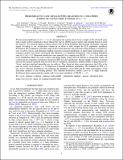| dc.contributor.author | Cooksey, Kathy L. | |
| dc.contributor.author | O’Meara, John M. | |
| dc.contributor.author | Glidden, Ana | |
| dc.contributor.author | Cooper, Thomas Jared | |
| dc.contributor.author | Simcoe, Robert A. | |
| dc.date.accessioned | 2017-04-11T14:46:09Z | |
| dc.date.available | 2017-04-11T14:46:09Z | |
| dc.date.issued | 2016-12 | |
| dc.date.submitted | 2016-10 | |
| dc.identifier.issn | 1538-4357 | |
| dc.identifier.issn | 0004-637X | |
| dc.identifier.uri | http://hdl.handle.net/1721.1/108046 | |
| dc.description.abstract | We measured metallicities for 33 z = 3.4–4.2 absorption line systems drawn from a sample of H i-selected-Lyman limit systems (LLSs) identified in Sloan Digital Sky Survey (SDSS) quasar spectra and stratified based on metal line features. We obtained higher-resolution spectra with the Keck Echellette Spectrograph and Imager, selecting targets according to our stratification scheme in an effort to fully sample the LLS population metallicity distribution. We established a plausible range of H i column densities and measured column densities (or limits) for ions of carbon, silicon, and aluminum, finding ionization-corrected metallicities or upper limits. Interestingly, our ionization models were better constrained with enhanced α-to-aluminum abundances, with a median abundance ratio of [α/Al] = 0.3. Measured metallicities were generally low, ranging from [M/H] = −3 to −1.68, with even lower metallicities likely for some systems with upper limits. Using survival statistics to incorporate limits, we constructed the cumulative distribution function (CDF) for LLS metallicities. Recent models of galaxy evolution propose that galaxies replenish their gas from the low-metallicity intergalactic medium (IGM) via high-density H i "flows" and eject enriched interstellar gas via outflows. Thus, there has been some expectation that LLSs at the peak of cosmic star formation (z ≈ 3) might have a bimodal metallicity distribution. We modeled our CDF as a mix of two Gaussian distributions, one reflecting the metallicity of the IGM and the other representative of the interstellar medium of star-forming galaxies. This bimodal distribution yielded a poor fit. A single Gaussian distribution better represented the sample with a low mean metallicity of [M/H] ≈ −2.5. | en_US |
| dc.description.sponsorship | Massachusetts Institute of Technology. Undergraduate Research Opportunities Program | en_US |
| dc.description.sponsorship | National Science Foundation (U.S.) (Award AST-1109915) | en_US |
| dc.language.iso | en_US | |
| dc.publisher | IOP Publishing | en_US |
| dc.relation.isversionof | http://dx.doi.org/10.3847/1538-4357/833/2/270 | en_US |
| dc.rights | Article is made available in accordance with the publisher's policy and may be subject to US copyright law. Please refer to the publisher's site for terms of use. | en_US |
| dc.source | IOP Publishing | en_US |
| dc.title | PREDOMINANTLY LOW METALLICITIES MEASURED IN A STRATIFIED SAMPLE OF LYMAN LIMIT SYSTEMS AT Z = 3.7 | en_US |
| dc.type | Article | en_US |
| dc.identifier.citation | Glidden, Ana et al. “PREDOMINANTLY LOW METALLICITIES MEASURED IN A STRATIFIED SAMPLE OF LYMAN LIMIT SYSTEMS AT Z = 3.7.” The Astrophysical Journal 833.2 (2016): 270. © 2016 The American Astronomical Society | en_US |
| dc.contributor.department | Massachusetts Institute of Technology. Department of Physics | en_US |
| dc.contributor.department | MIT Kavli Institute for Astrophysics and Space Research | en_US |
| dc.contributor.mitauthor | Glidden, Ana | |
| dc.contributor.mitauthor | Simcoe, Robert A | |
| dc.contributor.mitauthor | Cooper, Thomas Jared | |
| dc.relation.journal | Astrophysical Journal | en_US |
| dc.eprint.version | Final published version | en_US |
| dc.type.uri | http://purl.org/eprint/type/JournalArticle | en_US |
| eprint.status | http://purl.org/eprint/status/PeerReviewed | en_US |
| dspace.orderedauthors | Glidden, Ana; Cooper, Thomas J.; Cooksey, Kathy L.; Simcoe, Robert A.; O’Meara, John M. | en_US |
| dspace.embargo.terms | N | en_US |
| dc.identifier.orcid | https://orcid.org/0000-0003-3769-9559 | |
| dc.identifier.orcid | https://orcid.org/0000-0003-4063-5126 | |
| mit.license | PUBLISHER_POLICY | en_US |
